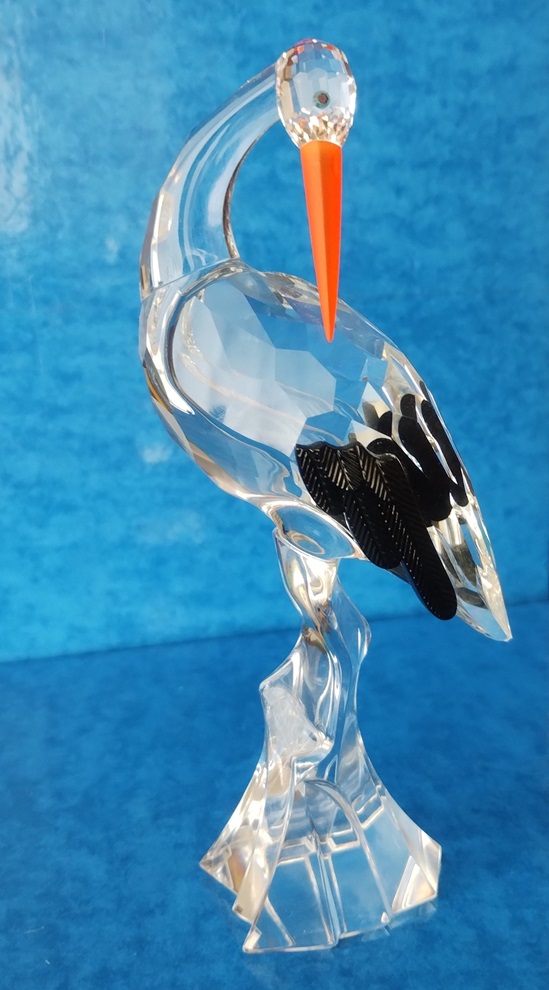
At a recent auction I purchased an apparently unbranded, crystal stork, simply because than I thought it was a wonderful piece of glass. Now I have it home I’m even more attached to it. After a bit of research, I realise that my intuition was right about how good it is.
Once a birder, always a birder
I’ve been a birder (or birdwatcher, if you prefer) since I was a child. It’s a hobby that has taken me all over Britain and, as an adult, a great deal further afield too. One of things about birding is that whilst you “go birding” you never actually stop. Every bird I see, wherever I am is looked at, considered and, whenever possible, identified. If you have a non-birder in the car when you’re driving, it can be a bit disconcerting for them…
When an identification isn’t immediately arrived at, that’s when it gets interesting. Birders always like to see a species they aren’t familiar with, that’s where the challenge is.
This mental habit of identification doesn’t stop at live birds. Any representation of birds is treated the same, including when I walk around antique shops or browse auction catalogues.
Bird identification, even in antiques shops!
Taxidermy specimens can be a real challenge when the specimen is moth eaten and faded. I always wonder who on earth wants to own these, but there’s always a buyer. Auction houses and antiques traders are terrible at cataloging taxidermy birds accurately. I have to concede thought that even with experience some examples are hard to identify. In fact, for taxidermy, dating and identification can matter. On more than one occasion I’ve queried the age and source of protected species I’ve come across in glass cases. It can cause some very worried looks.
Most ceramic models of birds are quite good representations of their avian subjects, at least good enough that it’s clear the artist hasn’t modelled a different species. At another time there’s a story to recount, but not today. It tells of a very well known ceramics manufacturer getting the species completely wrong. It wouldn’t really matter, but in this case the design was to celebrate the work of an ornithological charity!
Probably my personal favourite ceramic birds are the work of Karl Ens. The models sell for very modest prices but are always really excellent and very true to life. If you collect ceramic bird figures, they are well worth looking out for.
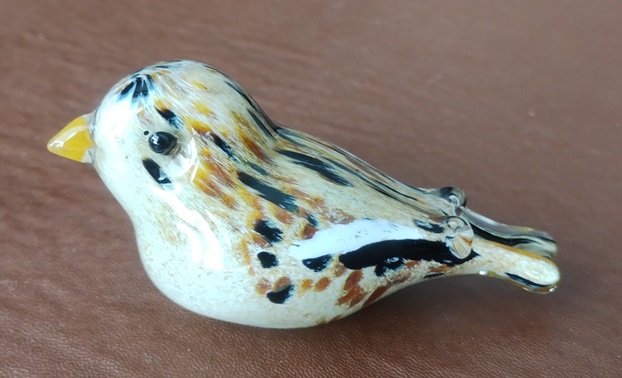
Glass models of birds are more of a challenge. Obviously no one expects a glassmaker to create a feather by feather representation of a bird, but when it is done well the essence of a species can be captured beautifully. The best I’ve seen at a very modest level is a beautiful model of a female Snow Bunting, made by Langham Glass in Norfolk. It cost me about £10 at an antiques fair, an absolute bargain for the quality of work. Langham Glass is no longer in Langham, but I have fond memories of calling in to visit the hot room in the middle of winter whilst on a birding trip to Norfolk back in the 1990s. It being winter, I’d almost certainly visited the beach at near-by Holkham to see Snow Buntings in the flesh (feather?).
An unnamed stork?
I have to be honest and say that I’m not usually taken by crystal models of anything, but the crystal stork was catalogued very modestly and was sold with another glass bird that I quite liked. We’re looking for more glass to sell at the moment and since I’d always look at a model of a bird in any auction, the stork was high on my hit list.
When I first saw it, the model was somewhat taller than I’d expected, and in spite of the poor lighting in the sale room it was very much brighter. That’s a good sign when you’re looking for crystal. It helps that the orange bill really stands out!
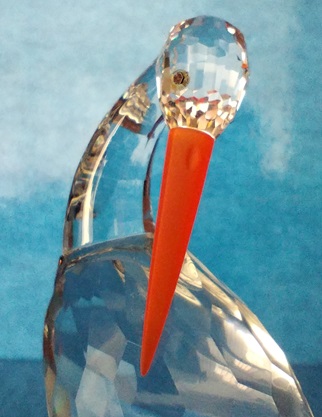
Starting at the basics and the identification, it’s obviously a model of a White Stork (Ciconia ciconia). The clear body is a good representation of the white feathering, the black (folded) wings are about the correct size and the bill whilst rather too orange, is a very passable colour for the real thing. Most importantly, the posture of the bird is beautifully accurate for a stork, albeit that in this case it also provides a well placed centre of gravity. For a figure that looks top heavy, it’s actually quite stable.
The model really captures the essence of a stork, whilst also being very beautiful. In the hand the weight immediately tells you it is crystal. Of course, in good light, the brightness of the light refractions are a giveaway.
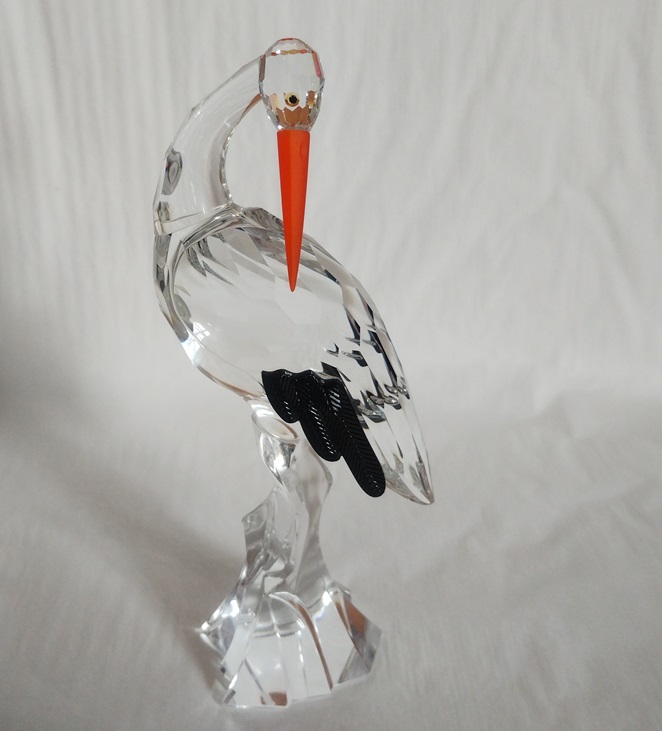
Crucially when you’re looking at glass, even in poor light, you should check there is no damage. If you’re ever in the position of checking glass, take your time. The tips of points obviously need a close look. This extends to the base which can get chipped as the item gets put down after moving or dusting. Whist this isn’t always a killer, it does detract greatly from the value. On smooth surfaced items close your eyes and use your finger tips to find areas of sharpness. Obviously on a figure such as the stork this isn’t so useful because the edges of each facet should be pointed but not rough.
If storks deliver babies, where did the stork come from? The search for a maker…
If you’re trying to sell glass you really need to identify the maker. Some companies leave their work unsigned. No matter how good a piece is, unsigned it will never sell for very much. Some volume produced work just gets a sticker and this is better than nothing. Many a Caithness paperweight has been highlighted as the star item in a mixed auction lot as the result of a slightly dog-eared label attached to the underside.
Better still though is when you get an engraved mark. Ideally you want two marks. A standard one that tells you the company name and then the personalised one of the maker’s signature. The glass collecting world is full of pieces of signed glass but the signature is indecipherable. At least if there is a company logo you know where to start looking when presented with an unreadable signature.
In the case of the stork, believing I had nothing to work from it was down to a web search. Here I was reminded of how poor web search engines can be at returning unbiased, accurate results. Various likely search terms in a couple of search engines produced nothing and so I thought the trail had gone cold.
A few days later I was admiring the stork again, but this time in sunlight. I was probably talking to it, pleading with it to tell me where it had come from. It just looked too good to be unsigned. As I looked again around the base for a maker’s mark, to my delight, there it was! It was actually reasonably clearly engraved on the base. I’d looked twice previously, and I would hope the auction house had made some effort too, but it was only in really good light that the engraving was visible. I’ve had the same even with the likes of Waterford crystal, where I knew there would be a maker’s mark and had a good idea where to look. In my defense, the Waterford mark is somewhat larger.

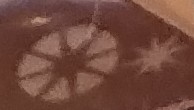
If you’re ever in the same position don’t give up until you’ve tried in different lights and have looked over and over. I’ve just picked the stork up again as I write this. Being in a darkish room whilst staring at a bright screen, I couldn’t immediately see the engraved mark, even though I know where it is.
Having found the maker’s mark, who did it belong to? Here I have to admit I had no idea, but once again to the web and a search. Again nothing immediately came to light although that’s probably down to my ignorance. Even with Google Lens, nothing obvious came up. The answer actually came from asking a question an internet forum. Some people are very helpful! So now at last I know that my stork was made by Preciosa of Czechia.
Interestingly, and as a cautionary tale, when I searched on the internet for “Preciosa crystal stork”, a couple of matching images were returned. I have to say I’m amazed and disappointed that nowhere in the pages of search results returned by Google for “crystal stork” was the matching image returned in the first ten or so pages of results.
Further searching revealed that the stork was designed in 2003 by Jitka Ryšavá, and that Jitka Ryšavá is the head of design at Preciosa. A very statisfying result in the end and one that should help to sell the stork should I ever decide to do so. For now, it’s going nowhere.
Post script
Remember how earlier I commented on how poor auction houses can be at cataloguing birds accurately? During my research for my crystal stork, I found one of them being listed at an auction house as a crane. OK, it’s a similar(ish) species but in this case the stork was being sold with its original box and certificate that said it was a stork! The auction house didn’t even read their own catalogue photograph.